Guardian reporters chart the president’s impact on foreign policy, the economy, the judiciary, the environment and immigration
by Julian Borger in Washington, Dominic Rushe, Oliver Laughland, Oliver Milman and David Taylor in New York
by Julian Borger in Washington, Dominic Rushe, Oliver Laughland, Oliver Milman and David Taylor in New York
Foreign policy
If there has been one defining trait in the foreign policy of the Trump era, it is confusion – not only in the frequent gaps between the paths taken by the president and his own administration, but also in the morass of contradictions and U-turns in his own impulses.While demonising the government in Tehran, Trump has decided not to directly contest Iranian influence in Syria with US troops. He threatened “fire and fury” against North Korea, but has since claimed to have “fallen in love” with Kim Jong-un, although the young dictator has yet to show any inclination to dismantle his nuclear arsenal.
He is reluctant to criticise Vladimir Putin, boosting suspicions that he is under the sway of the Kremlin. But his administration has arguably taken a tougher line against Russia than its predecessor, piling on more sanctions and supplying lethal weaponry to Ukraine.
There are some themes, however, that make foreign policy in the age of Trump quite different in character from any previous administration. One of them is the personalisation of relations with foreign governments.
Trump evidently trusts his gut instincts more than the advice of the US foreign policy and security establishment, and those instincts have drawn him towards autocrats and away from traditional democratic allies, whom he often views as freeloaders, taking advantage of US might.
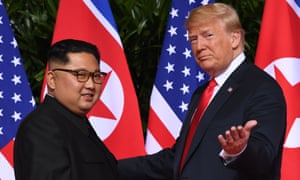
Another constant in the Trumpian approach to the world is the drive to erase the legacy of Barack Obama and his other predecessors. Almost everything Obama was for, Trump has been overwhelmingly against, from the 2015 nuclear deal with Iran to trade deals in the Pacific or with Europe, or the Paris climate accord.
The distrust of multilateral agreements and institutions is a third persistent theme. Trump’s template for making deals is two powerful men facing off across a table. Round tables with a variety of voices frustrate him, forcing him to listen to foreigners with less power or with different points of view. He chose John Bolton as national security adviser primarily to build a bonfire of US international obligations.
Trump has yet to be tested by an international crisis not of his own making. In the two years to come, we will see whether his (and the world’s) luck will continue to hold.
Economy
Unemployment is close to levels unseen since the first moon landing. It ticked up last month but even that rise came as more workers came off the sidelines and started looking for work. So far about 5m jobs have been created under Trump.It is pretty dubious to claim presidents “create” jobs but they all take the credit when things are good; unsurprisingly Trump is no exception. The current recovery clearly began under the previous president, Barack Obama. Even with the unarguably impressive improvements under Trump, he has a way to go before he can fulfil his promise of being “the greatest jobs president that God ever created”.
Bill Clinton holds the record for largest numeric increase in the workforce, 23m jobs over his two terms. Obama, who was elected in the teeth of the worst recession in living memory, added 10m jobs over his two terms.
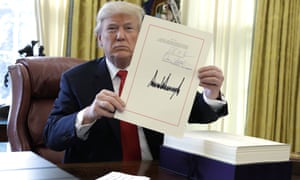
Trump is off to a great start, but it’s just that. The US has experienced 99 months of consecutive jobs growth and a slowdown seems inevitable.
Trump does, however, already have one over on Obama. Wage growth is finally picking up – a bit – after years of stagnation.
In other areas, Trump’s economic record is more discordant.
Trump’s single biggest policy achievement is the $1.5tn tax cut he pushed through in November 2017. Slammed by critics on the left and right as a giveaway for corporations and the 1%, it helped Democrats win in November’s midterm elections.
And then, of course, there’s Trump’s other most notable economic policy – trade wars. Trump has effectively torn up decades of trade agreements and antagonised his largest trading partners. The impact of the rancor he has sown is still being assessed but it has already triggered dramatic sell-offs on stock markets and may have contributed to a slowdown in the Chinese economy. Apple issued its first profits warning since 2002 earlier this month, blaming slowing business in China. There will be more warnings to come.
Trump’s economic populism helped get him elected. Whether he gets a second term will probably depend on whether he can keep the promises he made in the first, or whether the moves he made in the last two years come back to haunt him.
Judiciary
Call it Operation Patriarchy. Old white men are fighting a losing battle against changing demographics in the United States, but the 72-year-old president and 76-year-old Senate leader, Mitch McConnell, are doing their utmost to safeguard the supremacy of white men in American courts.For two years, they have been packing the courts with predominantly white male conservative judges, whose lifetime appointments will mean the federal benches look a lot less like the country they preside over.
That may sound like business as usual for a party in power but it is actually the product of McConnell’s long-term strategy. He blocked dozens of Obama nominees for the federal courts by refusing to hold Senate votes, gambling that in 2016 a Republican might win the presidency and present a roster of more conservative judges.
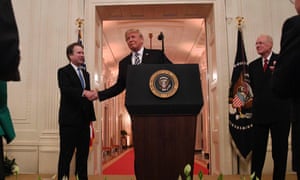
After the 2016 death of the supreme court justice Antonin Scalia, McConnell used his control of the Senate to keep the seat vacant for 293 days by refusing a hearing for Obama’s nominee, Merrick Garland.
For white evangelical Christians, a vacant seat on the supreme court was the most compelling reason to vote for Trump, the thrice-married alleged serial adulterer who boasted of sexually interfering with women.
After winning the presidency, Trump nominated a conservative in Neil Gorsuch.
In 2018, Brett Kavanaugh’s supreme court nomination was forced through after a vitriolic and incomplete examination of past sexual assault allegations, which he denied.
Trump and McConnell delivered a conservative majority on the court, which could now last decades and gives hopes of of overturning the the 1973 Roe v Wade decision, which enshrined the right to abortion.
McConnell and Trump have also been moving rapidly to shift the appeal and district courts to the right.
So far, 85 judges have been appointed by Trump – two to the supreme court, 30 for the US courts of appeal and 53 to district courts. That is a faster pace than Obama who, in eight years, appointed two supreme court justices, 55 appeal judges and 268 district judges.
Trump has 70 more nominations in the pipeline which can be approved by a simple majority vote in the Senate, where Republicans hold a 53-47 advantage. Dominated by white men, many under 50, Trump’s appointments are already the least diverse crop of new judges for a generation.
The House, newly controlled by the Democrats under the leadership of Nancy Pelosi, can stop Republican legislation. But Democrats on Capitol Hill are helpless against Trump’s determination to install as many judges as possible.
Environment
Trump’s stewardship of the environment is perhaps best known for the president’s dismissal of climate change as a Chinese hoax, or the allegations of flamboyant levels of corruption by Scott Pruitt and Ryan Zinke, the now former heads of the Environmental Protection Agency and interior department, respectively.But it’s the more mundane unspooling of arcane regulations by the administration that is most likely to leave a tangible mark on the health of Americans and the world around them.
This work is ploddingly tenacious. For example, during the somnambulant period between Christmas and the New Year, the EPA decided that rules curbing emissions of mercury, linked to neurological disorders, heart and lung problems and compromised immune systems, are too onerous on coal plants and should be scrapped.
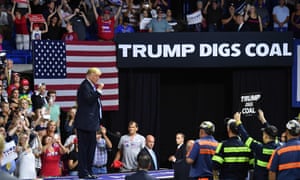
The proposed reversal is just the latest in a list of about 80 environmental rules either dismantled or slated for abolition by the Trump administration. They include the destruction of the main Obama-era policy to reduce greenhouse gas emissions from energy, the halting of a planned ban of a pesticide deemed harmful to infants’ development and a weakening of fuel efficiency standards for cars.
The new vehicles regime sets up a bitter fight with California, which has stricter pollution rules for cars and trucks than the federal standards. A cavalcade of legal action on other issues is also expected to play out this year as environmental groups attempt to strike down the Trumpian rollbacks.
However, unlike many other areas of life, any sort of delay is almost as harmful as active worsening, with the world’s climate swiftly heating up to an unbearable point for many Americans, who already face increasingly punishing hurricanes, rising seas and apocalyptic wildfires.
In October, a landmark report by UN Intergovernmental Panel on Climate Change warned there is only a dozen years left to prevent global temperatures tipping beyond a point where droughts, floods, extreme heat and poverty become horrendously worse.
In response, Trump claimed to have a “natural instinct for science” because his uncle, John Trump, was a professor of engineering at the Massachusetts Institute of Technology. The president added that the climate “goes back and forth, back and forth” before delivering his verdict on the IPCC report itself. “I don’t believe it,” he said.
Immigration
It took global condemnation and sustained bipartisan criticism at home for Donald Trump to show he had limits on how much suffering immigrants should endure for his own political gain.For three months in 2018 Trump admitted forcibly separating migrant children from their families, provoking scenes of desperation in border courtrooms and detention centres as mothers and fathers begged to have their children returned. In fact it may have been separating thousands of children since 2017.
Trump’s daughter and senior adviser Ivanka described those months as “a low point” for the administration, which formally abandoned the policy in June.
And yet, a single U-turn aside, the administration continues to pursue an extremist agenda on immigration, keeping families separated in different, more insidious, ways.
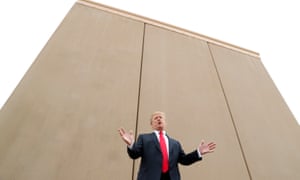
Trump’s travel ban, targeting a number of Muslim-majority countries, has stopped family members in some of the world’s most unstable regions from visiting their loved ones in America. Most recently a woman from Yemen was temporarily prevented from visiting her terminally ill two-year-old son, an American citizen.
The administration, having supercharged immigration enforcement agents’ power, continues to drive up the number of arrests and deportations of undocumented people – most with no serious criminal history. Now a record 44,000 people are held in immigration detention as the immigration court backlog swells to a record high. Thousands of those facing deportation have lived in America for decades, building families and new lives here.
Meanwhile the administration has cut the number of refugees allowed into the country to a record low of 30,000. It has slashed the number of successful green card applications. And Trump has personally threatened to try to end birthright citizenship.
Of course, there is also Trump’s infamous campaign pledge to build a wall along the US’s southern border, which he concedes will not now be funded by Mexico, or made of concrete.
Despite a government shutdown over wall funding crippling parts of the federal government, it is those most vulnerable, namely asylum seekers forced to languish just outside the US, who endure the most as a consequence of Trump’s relentless pursuit of an ineffective solution to a complex problem on the border.
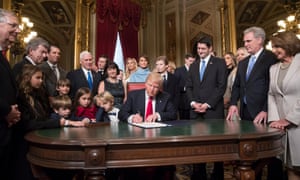
No comments:
Post a Comment